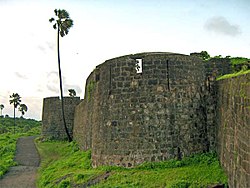|
Madh Island
Madh Island (Marathi pronunciation: [məɖʱ]) is a group of several quaint fishing villages and farmlands in northern Mumbai. GeographyThe area is bounded by the Arabian Sea to the west, and Malad Creek on the east. There are s few beaches, such as Erangal Beach, Dana Pani Beach, Silver Beach, and Aksa Beach. AccessibilityThe area is accessible by bus service (#271 to Malad and #269 to Borivali) or an autorickshaw from Malad. There is also a ferry service from Versova. One can reach Madh Island by a ferry service or speed boat from Versova Jetty and cross over in five minutes. The fare for traveling from Versova to Madh Jetty is Rs. 5 per passenger and Rs. 10 per two-wheeler. Four-wheeled vehicles are not permitted on the jetty. Many residents of Madh Island choose to use the jetty for their trips to South Mumbai due to its convenience and time-saving benefits. The road from Madh to Malad is often in poor condition, particularly during the monsoon season, and traffic congestion is exacerbated by the popularity of Aksa Beach, which attracts many locals. The construction of the sealink between Versova and Bandra has already commenced. However, the project for a sealink between Versova and Madh Island has been ongoing for the past 10 years, with tenders being floated multiple times but never awarded. Local fishermen oppose this sealink, likely due to fears that improved connectivity could attract real estate developers. The sea-facing land in Madh Island could potentially become a prime location for guest houses, water parks, and hotels. DemographicsThe area is a rural area inhabited primarily by Kolis, Marathi, Bombay East Indians, Roman Catholics in Madh village as well as by people from other communities. The area is home to a significant Muslim community, alongside a large number of migrants from various Indian states, including Uttar Pradesh, Bihar, and Andhra Pradesh, who work as laborers in the fishing industry. Additionally, there is a presence of immigrants from Bangladesh who contribute to fishing and the fish-drying processes. FacilitiesMadh Island is essentially a village and bears little resemblance to the bustling city of Mumbai. In Madh village, you’ll find basic amenities such as shops for groceries, confectionery, stationery, vehicle repair, and dairy products. However, there are no branded stores, and food delivery services like Zomato and Swiggy are not available in the area. However, online shopping portals do offer delivery services to the area. The pin code for Madh Island is 400061. Madh Island is home to numerous film studios; there's are facilities available for rent for film shoots and events. Madh FortMadh Fort is a small fort in northern Mumbai, India situated at Madh Island. It was built by the Portuguese in Portuguese occupied India.[1] They lost it during the war against Maratha empire when the Maratha Empire captured it in February 1739. The British occupied Salsette Island, Thana Fort, Fort Versova, and the island fort of Karanja in 1774.[2] It is secluded and difficult to reach, about 15 kilometres (9 mi) from Malad and is the last stop on Route 271 of BEST bus service or via Versova by ferry boat. Bus Number 269 departs from Borivali and reaches its final stop at Madh Jetty, passing Harba Devi Mandir along the way. The road from Harba Devi Mandir continues on to Madh Fort. Auto rickshaws are readily available at both Madh Jetty and Harba Devi Bus Stop, providing convenient transportation to Madh Fort. The fort was built by the Portuguese, as a watchtower in the 17th century. It offers a strategic view of the coastline and guards the Marve Creek. Its external façade is intact but internally it is dilapidated. It is under control of the Indian Air Force as it is located close to an Indian Air Force base and permission is needed for accessing it. Madh Fort is not open to the public, and it is surrounded by local fishermen communities. There is a prominent odor of drying fish in the surrounding area, which can make visiting the place uncomfortable, particularly for vegetarians. However, this fish drying process halts during the monsoon season due to the heavy rains, resulting in a much more pleasant environment for visitors. In popular cultureSome Bollywood films like Deewana, Singham Again, Kisi Ka Bhai Kisi Ki Jaan, Love Ke Liye Kuchh Bhi Karega, Baazigar, Shootout at Wadala, and Manmohan Desai's 1985 film Mard, Zamana Deewana, Khalnayak, Shatranj and Tarazu, Game Paisa Ladki were shot at this location. Many episodes of the popular serials Naamkarann, Chandrakanta, C.I.D., Aahat and SuperCops vs Supervillains. The location is often referenced by standup comedian Kapil Sharma in his popular comedy show, The Kapil Sharma Show, in his jokes on presenter and permanent guest Archana Puran Singh, who lives in the area. Gallery
See alsoReferences
|
||||||||||||||||||||












